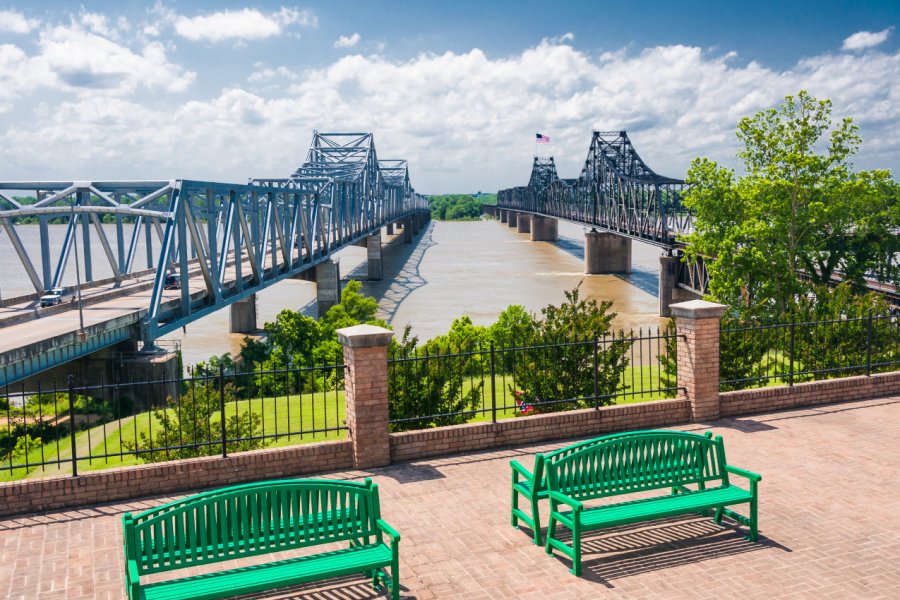Travel Guide Vicksburg
Find an accommodation
Advertising
Rode is a small town with 24 000 inhabitants overlooking Mississippi, 43 miles west of Jackson. In addition to its casinos on the edge of the river, which drain a predominantly regional population, it owes its current interest to its geographical position, but above all to its history, particularly during the war of Secession.In 1790, the Spanish founded a military outpost on the site, called Fort Nogales. When the Americans took possession in 1798, the name was changed in Walnut Hills. From 1801 onwards, the Choctaws Indians, who had settled on the vast lands surrounding them since they had expelled the Nachez (alongside the French, around 1730), gradually yield their territories to the settlers through successive treaties. In 1825, Walnuts Hills took the name Rode, according to that of Newitt Vick, a Methodist pastor who had established a mission. Vilksburg quickly became the centre of an aristocracy whose wealth was based on the cotton and wood trade.During the civil war, the siege of the city, a veritable fortress on the heights of the river, was one of the major episodes of the conflict and the term of the Rode campaign (26 December 1862 - 4 July 1863). Following a succession of manoeuvres, the army of Tennessee, led by Major-General Ulysses S. Grant (1822-1885), crossed the river and forced the confederate army, commanded by Lieutenant-General John C. Pemberton (1814-1881), to hide inside the city. After two unsuccessful assaults on the fortifications on May 19 and May 22, 1863, Grant decided to lay siege to the city. In the absence of strengthening the fortifications and its depleted food, the garrison surrendered on 4 July, after 47 days of resistance. Grant's victory allowed the Union to take control of the entire Mississippi River. It coincided with the defeat of General Robert E. Lee, the day before Gettysburg. These two events marked the turning point of the war and the beginning of the defeat of the Confederate states. Rode, who remained occupied until 1877 despite his readmission in the United States in 1870, will no longer celebrate Independence Day, which also marked his surrender, for 81 years.By walking through the city centre, you can make a good idea of what Rode looked like almost a century and a half ago. The past glory of the city is found in its saved heritage: many churches (two of them to Tiffany stained glass stained glass windows), public buildings and beautiful mansions dating from the th century. The oldest building, the Old Court House Museum, was built in 1858 and survived the civil war with minimal damage.Two Scenic Drives (red and blue) allow you to tour the city and the most beautiful properties. Among them are Anchuca, the first house to colonnades that was built in Rode, in 1830.On the Mississippi dam, close to the city centre, murals are the striking episodes of the history of La. They plush between one of the floating casinos and the Old Depot Museum in the old restored station. A little further afield is the Lower Mississippi River Museum, with the dry dock exhibition of the Mississippi IV.Rode is the birthplace of Joseph Biedenharn (1866-1952), a merchant who had the idea, in 1894, to bottle Coca-Cola delivered in drums since 1866. It was also here that Myrlie Evers-Williams (1933) was a famous journalist and civil rights activist who fought for more than 30 years to obtain justice after the murder of her husband, Medgar Evers Wiley (1925-1963) in 1963.
What to visit Vicksburg?
Advertising
Suggested addresses Vicksburg
Weather at the moment
Advertising
Organize your trip with our partners Vicksburg
Transportation
Book your plane tickets
Car Rental
Boat rental
Accommodation & stays
Find a hotel
Holiday rental
Find your campsite
Tailor-made trip
Immersion travel
Services / On site
Activities & visits
Find a doctor
Vicksburg travel inspiration
Find unique Stay Offers with our Partners
Pictures and images Vicksburg
Other destinations nearby Vicksburg
100 km away
















